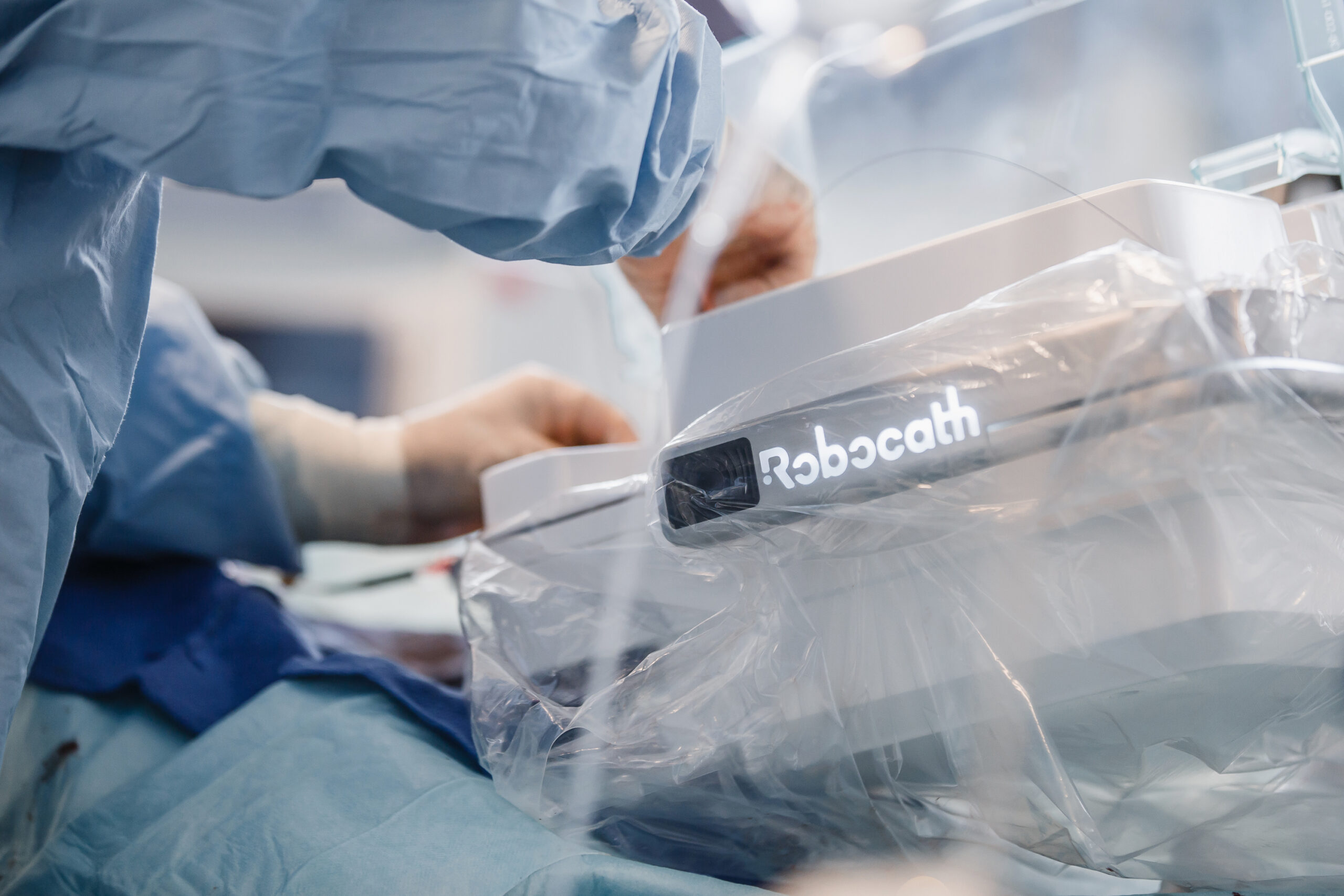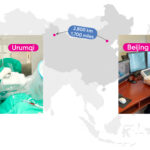Share this post:

- End of study brings Robocath closer to commercializing R-One in China in 2023
- 149 patients enrolled over six months in four Chinese centers
- Results of first vascular robotics study on this scale in China will be published in March 2023
Rouen, France, July 20, 2022 – Robocath, a company that designs, develops and commercializes innovative robotic platforms for the treatment of vascular diseases, announces today that its joint venture, Cathbot, established in 2020 with MicroPort through its robotic subsidiary MedBot, has enrolled the last patient in its clinical study in China. This is the first step towards obtaining approval from China’s National Medical Products Administration (NMPA) for the commercialization of R-One™, its robotic solution for PCI (Percutaneous Coronary Intervention) in the Chinese market, where this is the first clinical study conducted on this scale in the field of vascular robotics.
This multi-center clinical study began in November 2021 and has enrolled 149 patients over six months, right on schedule despite the sanitary conditions linked to Covid-19. Four hospital centers participated in the trial: the No. 301 Hospital, the leading unit, with Professor Yundai Chen; the Shanxi Cardiovascular Hospital, with Professor Jian An; the Meizhou People’s Hospital, with Professor Zhixiong Zhong, and the People’s Hospital of Xinjiang Uygur Autonomous Region, with Professor Yining Yang. The last patient was enrolled in May 2022.
“I am deeply impressed by the accuracy and quick learning curve of R-One. Not only can it complete the positioning of the balloon and stent catheter precisely, it also enables manipulation of two guidewires, one of them being parked in a stand-by path, facilitating complex PCI presenting tortuous and/or calcified lesions. This could reduce the risk of intraoperative and post-operative complications, which would benefit both patients and operators,” said Professor Yundai Chen, director of the cardiology department at the No. 301 Hospital.
“The simple and intuitive design of R-One is very convenient for doctors to operate with. We can get started after only short-term training. Additionally, we can complete the intervention whilst being totally protected by sitting in front of the X-ray-proof console and manipulating the devices using only the joysticks. We look forward to working with R-One on a daily basis to benefit more patients and doctors,” commented Professor Jian An, department of cardiovascular medicine, dean of the Shanxi Cardiovascular Hospital.
“R-One drastically improves our working conditions. First, we can operate while fully protected from radiation; compared to manual interventions where we need to stand for long hours, only a few centimeters from the X-ray tube, which can induce serious diseases, like cancer, and orthopedic injuries. Second, it offers a high level of precision which directly benefits the patient,” added Professor Zhixiong Zhong, dean of the Meizhou People’s Hospital.
“During the clinical trial, R-One has been reliable in several consecutive PCI procedures. This technology will benefit doctors and many patients living with cardiovascular diseases all over the country: today, in China, more than one million procedures are performed annually across roughly 2,000 PCI centers,” noted Professor Yining Yang, dean of the People’s Hospital of Xinjiang Uygur Autonomous Region.
“The completion of this clinical trial is a crucial milestone in our development. It is the first PCI robotic multicenter trial completed in China. I am very impressed with the commitment of the Cathbot team and the medical staff. They worked very hard to make it happen on time and to maintain our strategic plans despite the lockdowns. I sincerely thank all of them. Our greatest global ambition is to be able to better treat cardiovascular diseases. R-One will allow the medical staff to work safely while bringing precision to the intervention,”said Philippe Bencteux, president and founder of Robocath and president of Cathbot.
“We look forward to receiving the results of this study, that will undoubtedly confirm the ease of use and intuitiveness of R-One. This clinical trial is the first step towards the commercialization of R-One in China,” added Lucien Goffart, CEO of Robocath.
“In the field of vascular robotics, the successful completion of this multi-center clinical trial project with R-One is an important milestone for Cathbot. It is of extraordinary significance for promoting more accurate and intelligent interventional medicine. In the future, R-One will be equipped with 5G and AI features, and combined with technologies such as vascular structure imaging and hemodynamic monitoring to achieve more innovative breakthroughs. Our ambition is to provide the best treatment for patients thanks to accurate, intelligent and better integrated robotic solutions,” concluded Dr. Chao He, president of MicroPort® MedBot®.
ABOUT MEDBOT
Founded in 2014, MedBot develops intelligent surgical robotic systems and solutions. It is committed to meeting the most cutting-edge development needs of minimally invasive surgery and innovatively providing integrated intelligent surgical solutions that can save patients’ lives or improve their quality of life. Following years of research and development, innovation and industrial accumulation, MedBot has grown to become a medical robot company that masters the underlying technology in the entire chain. With its three flagship products in the three major segments, namely the Toumai™ laparoscopic surgical robot, Skywalker™ joint replacement surgical robot and DFVision™ three-dimensional electronic laparoscope, and having entered the special approval procedure (Green Path) for innovative medical devices at the National Medical Products Administration (NMPA), Medbot is the only surgical robot company with three ‘Green Path’ grants in the People’s Republic of China (PRC). Its current business covers five areas, including endoscopy, orthopedics, vascular intervention, natural orifice and percutaneous puncture.
ABOUT MICROPORT
MicroPort® was founded in 1998 in ZJ Hi-Tech Park in Shanghai China, where a group of dedicated individuals joined together in the common belief that advancements in medical technology could transform patients’ lives in China and around the globe. Over the last two decades, MicroPort has taken important steps towards fulfilling its mission of providing access to the best means of prolonging and reshaping lives. Today, MicroPort is focused on covering ten major areas, including cardiovascular intervention & structural heart diseases, electrophysiology & cardiac rhythm management, orthopedics & soft tissue repair, endovascular & peripheral vascular diseases, neurovascular intervention & neurosciences, life sciences (endocrine management), surgical devices & medical robotics, urology & gynecology & respiratory & gastroenterology, aesthetics & rehabilitation, and in vitro diagnostics & medical imaging. Thanks to over 300 MicroPort devices currently approved for use in nearly 10,000 hospitals worldwide, one of our devices is used every six seconds. With a vast global footprint of R&D and manufacturing sites (Shanghai; Memphis, TN in the United States; Clamart in France; Saluggia in Italy; Santo Domingo in the Dominican Republic), a strong focus on technology innovation with over 4,700 patent applications, and a global workforce of over 7,000 employees, MicroPort is committed to its vision of building a people centric consortium of companies focused on emerging medical technologies.
ABOUT ROBOCATH
Founded in 2009 by Philippe Bencteux, MD, Robocath designs, develops and commercializes robotic solutions to treat cardiovascular diseases. As an active player in the evolving medical robotics industry, these innovative solutions aim to make medical procedures safer, while complementing manual interventions.
R-One™ is the first solution developed by Robocath. It uses a unique bionic technology that optimizes the safety of robotic-assisted coronary angioplasty. This medical procedure consists of revascularizing the cardiac muscle by inserting one or more implants (stents) into the arteries that supply it with blood. Every 30 seconds, somewhere in the world, this type of procedure is performed. R-One is designed to operate with precision and perform accurate movements, creating better interventional conditions. Thanks to its open architecture, R-One is compatible with market-leading devices and catheter labs.
R-One received the CE marking in 2019. In a prospective, multicenter, non-randomized, single-arm clinical trial, R-One demonstrated safety and efficacy as it achieved more than 95% technical procedure success with no MACE (major adverse cardiovascular events). Currently R-One is used in Europe, Africa and China.
Robocath aims to become the world leader in vascular robotics and develop remote treatment of vascular emergencies, guaranteeing the best care for all. Based in Rouen, France, Robocath has more than 70 employees.
To download documents, you can right-click on the links above and chose « Save link as… »




